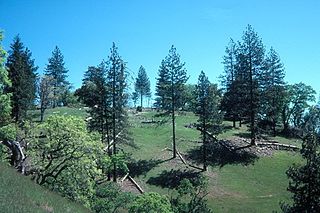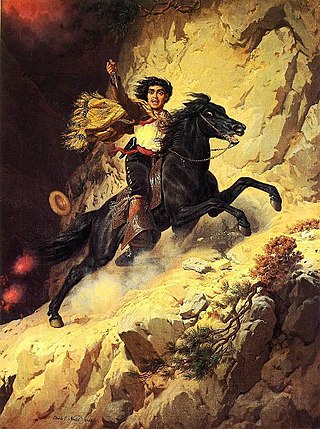Related Research Articles

Henry W. Coe State Park is a state park of California, United States, preserving a vast tract of the Diablo Range. The park is located closest to the city of Morgan Hill, and is located in both Santa Clara and Stanislaus counties. The park contains over 87,000 acres (35,000 ha), making it the largest state park in northern California, and the second-largest in the state. Managed within its boundaries is a designated wilderness area of about 22,000 acres (8,900 ha). This is officially known as the Henry W. Coe State Wilderness, but locally as the Orestimba Wilderness. The 89,164-acre (36,083 ha) park was established in 1959.
Point of Timber is a former settlement in Contra Costa County, California. It was located on Indian Slough 2 miles (3.2 km) north of Byron, and about 2.5 miles east of Union Cemetery in Brentwood. It was originally named Point of Timber Landing. The landing was built by Josiah Wills, who organized the deepening of Indian Slough, connecting the landing to the Old River. Point of Timber got its name from the mile wide strip of open Oak woodland that ran from just east of the house of John Marsh along the course of Arroyo del Sur to the edge of the marshes bordering Indian Slough and Old River.
Cantua Creek, formerly in Spanish Arroyo de Cantúa, was named for José de Guadalupe Cantúa, a prominent Californio Ranchero in the 19th-century Mexican era of Alta California.
La Vereda del Monte was a backcountry route through remote regions of the Diablo Range, one of the California Coast Ranges. La Vereda del Monte was the upper part of La Vereda Caballo,, used by mesteñeros from the early 1840s to drive Alta California horses to Sonora for sale.
Blackbird Valley, earlier known as "Valle de Mocho", is a valley south of Mount Mocho in the Diablo Range in Santa Clara County, California. It lies at an elevation of 2,552 foot / 778 meters.
Kellogg Creek is a tributary of Indian Slough, in Contra Costa County, California. Indian Slough itself is a tributary of the Old River, an old channel of the San Joaquin River. Kellogg Creek was formerly named Arroyo Santa Ángela de Fulgino by Pedro Font, on April 4, 1776, as the expedition of Juan Bautista de Anza passed through the area. In the 19th century it was known to the Californios as Arroyo del Sur.
Isabel Valley is a valley in the Diablo Range in Santa Clara County, California. It is also known as Santa Ysabel Valley.
Mississippi Creek is a tributary stream to Pacheco Creek in Santa Clara County, California.
Valle Atravesado,, a small, east-west running valley that crosses the north-south running valley of the upper reach of Mississippi Creek in the Diablo Range, in Santa Clara County, California.
Frenchs Flat is a flat along the divide of the Diablo Range south of Pacheco Pass in Santa Clara County, California. It lies at an elevation of 1,362 feet south southwest of Pacheco Pass.
Mustang Peak is a mountain summit along the divide of the Diablo Range in Stanislaus County, California. It rises to an elevation of 2,251 / 686 meters.
Paradise Flat is a flat in the Diablo Range, within Henry W. Coe State Park in Stanislaus County, California. It lies at an elevation of 1,224 / 373 meters along north bank of the South Fork Orestimba Creek, just above the Rooster Comb.
Mustang Flat is a flat in the Diablo Range in Stanislaus County, California. It lies at an elevation of 1,329 feet south of the South Fork Orestimba Creek, north of Mustang Peak.
Frenchs Pass is a gap on the divide of the Diablo Range and on the boundary of San Benito County and Merced County, California. The pass is at an elevation of 2,428 feet on the north shoulder of 3,257-foot Antimony Peak.
Valle Hondo, a small flat in the canyon along the course of North Fork Pacheco Creek in Henry W. Coe State Park in Santa Clara County, California. It lies at an elevation of 1,698 feet. Formerly a Native American rancheria, then an overnight camp along La Vereda del Monte, and then for local ranchers, it is now the site of Pacheco Camp in the state park and is located where the Pacheco Creek Trail meets Coit Road, which borders the flat on its south side.
Fifield Ranch is a locale within the Diablo Range in Santa Clara County, California. It lies at an elevation of 1,512 feet, west of the head of Romero Creek and the Santa Clara County line, about a mile north of Hagerman Peak. It is at the source of a tributary canyon and stream to Chimney Gulch, itself a tributary of East Fork Pacheco Creek.
County Line Road is an unimproved road between the San Antonio Valley and Fifield Ranch that closely follows the east-west divide of the Diablo Range and the County boundary of Santa Clara County, and Stanislaus County, California. This road followed the route called La Vereda del Monte, used by Californio mesteñeros and the gang of Joaquin Murrieta and other bandits and horse-thieves, and sites of three of their camps along the route are found along it. Two sites are now state park campgrounds, the last is at ranch dating back to the 1860s.
Bullhead Canyon, is a canyon and tributary stream of the North Fork Pacheco Creek in Santa Clara County, California. Its mouth is on its confluence with North Fork Pacheco Creek at an elevation of 630 feet / 192 meters. Its source and its upper reach is at 37°10′08″N121°19′04″W within the boundary of Henry W. Coe State Park. It is overlooked to the north by the County Line Road,, that runs west to east along the divide of the Diablo Range and the boundary of Santa Clara and Stanislaus County, California.

Murrieta Spring is a historic spring flowing from the south bank of Cantua Creek, about 100 yards above where El Camino Viejo crossed the Creek in the San Joaquin Valley. The Spring formed a pool in the arroyo where it emerged from the foot of the eastern mountains of the Diablo Range, a mile above where formerly California State Route 33, now South Derrick Avenue, crosses Cantua Creek. This is where Harry Love and his detachment of California Rangers found the gang of Joaquin Murrieta at the spring and attacked them on July 25, 1853.
Joaquin Spring, originally known as Valenzuela Spring, is a spring on Joaquin Ridge in the Diablo Range in Fresno County, California. The spring is located on the southwestern slope of the ridge, about 500 feet below Joaquin Rocks, at an elevation of 3,520 feet / 1,073 meters.
References
- ↑ U.S. Geological Survey Geographic Names Information System: French Ranch
- ↑ Frank F. Latta, JOAQUIN MURRIETA AND HIS HORSE GANGS, Bear State Books, Santa Cruz, California. 1980.
Coordinates: 36°56′48″N121°14′17″W / 36.94667°N 121.23806°W